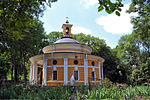Tomb of the Unknown Soldier (Kyiv)
Buildings and structures completed in 1957Monuments and memorials built in the Soviet UnionMonuments and memorials in KyivSoviet military memorials and cemeteries in UkraineTombs of Unknown Soldiers

The Tomb of the Unknown Soldier (Ukrainian: Могила невідомого солдата) is a war memorial located in the Ukrainian capital of Kyiv, dedicated to the soldiers of the Red Army killed in the Second World War. It is situated at the Memorial of Eternal Glory inside the Park of Eternal Glory. The memorial is a 27 meters high obelisk, with an eternal flame burning at the tomb. The Alley of Heroes leads to the tomb.
Excerpt from the Wikipedia article Tomb of the Unknown Soldier (Kyiv) (License: CC BY-SA 3.0, Authors, Images).Tomb of the Unknown Soldier (Kyiv)
Fallen Heroes Alley, Kyiv Pechersk
Geographical coordinates (GPS) Address External links Nearby Places Show on map
Geographical coordinates (GPS)
| Latitude | Longitude |
|---|---|
| N 50.4391 ° | E 30.5532 ° |
Address
Меморіал Вічної Слави
Fallen Heroes Alley
01010 Kyiv, Pechersk
Ukraine
Open on Google Maps











